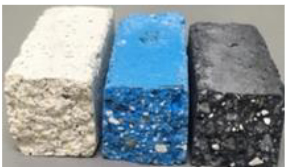Pigmented mortars with high waterproofing for use in finishes
DOI:
https://doi.org/10.22517/23447214.25298Keywords:
Absorption, compression , impermeability , mortars , porosity , resistanceAbstract
In the present study, the development of pigmented cement mortar for outdoor applications, aiming to replace traditional finishes, especially in pool settings, was investigated. The study used the properties of workability, particle size, and strength from a commercial sample (CS) as a reference, complying with regulations for pool finishes. In the initial stage, the additive/binder (A/B) and water/cement (W/C) ratios were varied to achieve workability similar to the CS reference. Compression strength and porosity were evaluated as response variables according to ASTM C642 standards at 1, 7, and 28 days of curing. In a subsequent stage, the aggregate/cement ratio was reduced to enhance mechanical performance and reduce porosity. Additionally, colorants were introduced, and compression strength at 1, 7, and 28 days, three-point flexural strength, and the percentage of permeable pores at 28 days were assessed. Pigmented mortars exhibited compressive strengths exceeding 35 MPa, flexural strengths exceeding 5 MPa, and a volume percentage of pores below 8% after 28 days of curing.
Downloads
References
[1] E. Gonzalez-Diaz, E. Jaizme-Vega y J. Jubera-Pérez, «Assessment of the Influence of the Effective Water-Cement Ratio on the Workability and Strength of a Commercial Concrete Used for the Construction of Concrete Caissons,» Revista de la Construccion, vol. 2, nº 17, pp. 231-239, 2018. DOI: https://doi.org/10.7764/RDLC.17.2.231
[2] J. C. Okah y E. N. J. Amos, «Effect of Aggregate / Cement and Water / Cement Ratios on Concrete Workability,» IIARD International Journal of Geography and Environmental Management, vol. 4, nº 4, pp. 89-99, 2018.
[3]P. Mika, «The capabilities of using concrete in sustainable architecture.,» de Conference: International Multidisciplinary Scientific Conferences on Social Sciences & Arts 3-9 September 2014, BulgariaAt: Bulgaria, 2014. DOI: https://doi.org/10.5593/sgemsocial2014/B41/S15.123
[4]M. Utěšená y R. Pernicová, «Color Intensity of Architectural Concrete Depending on the Type of Cement,» Materials Science Forum, vol. 986, pp. 50-54, 2020. DOI: https://doi.org/10.4028/www.scientific.net/MSF.986.50
[5]ASTM-C109, Standard Test Method for Compressive Strength of Hydraulic Cement Mortars (Using 2-in. or [50-mm] Cube Specimens), ASTM C109/C109M-20, 2020.
[6]J. Chen, W. Du, G. Zhao, M. Shi y B. Xue, «Effect of Aggregate Size and Water/Cement on Compressive Strength and Physiological Performance of Planting Concrete,» MDPI Materials, vol. 6685, nº 15, pp. 1-15, 2022. DOI: https://doi.org/10.3390/ma15196685
[7]NTC-112, Cementos: mezcla mecánica de pastas y morteros de cemento hidráulico de consistencia plástica, Bogotá, 2021.
[8]ASTM-C642, Standard Test Method for Density, Absorption, and Voids in Hardened Concrete, 2022.
[9]S. Jayasingh y T. Selvaraj, «Influence of organic additive on carbonation of air lime mortar - changes in mechanical and mineralogical characteristics,» European Journal of Environmental and Civil Engineering, vol. 26, nº 3, pp. 1-16, 2020.DOI: https://doi.org/10.1080/19648189.2020.1731716
[10]W. Xun, C. Wu, X. Leng, J. Li , D. Xin y Y. Li, «Effect of Functional Superplasticizers on Concrete,» MDPI Applied Sciences, vol. 10, nº 3496, pp. 1-16, 2020. DOI: https://doi.org/10.3390/app10103496
[11] J. Yoon, H. Kim, S. Sung-Han y S. Pyo, «Characterization of Porous Cementitious Materials Using Microscopic Image Processing and X-ray CT Analysis,» MPDI Mataterials, vol. 13, nº 3105, pp. 1-16, 2020. DOI: https://doi.org/10.3390/ma13143105
[12]S. H. Kosmatka, B. Kerkhoff y W. C. Panarese, Design and Control of Concrete Mixtures, Skokie Illinois: PCA R&D, 2002.
[13]A. R. Gangolu y B. Prasad, «Influence of the Roughness of Aggregate Surface on the Interface Bond Strength,» Cement and Concrete Research , vol. 2, nº 32, p. 253-257. DOI: https://doi.org/10.1016/S0008-8846(01)00668-8
[14] J. Yang, G. Li, W. Yang y J. Guan, «Effect of Polycarboxylic Grinding Aid on Cement Chemistry and Properties,» Polymers, vol. 14, nº 3905, pp. 1-11, 2022. DOI: https://doi.org/10.3390/polym14183905
[15] J. J. Assaad, M. Mata y J. Saade, «Effect of pigments on bond strength between coloured concrete and steel reinforcement,» Acta Polytechnica, vol. 62, pp. 248-261, 2022. DOI: https://doi.org/10.14311/AP.2022.62.0248

Downloads
-
Vistas(Views): 387
- PDF (Español (España)) Descargas(Downloads): 185
- HTML (Español (España)) Descargas(Downloads): 28
Published
How to Cite
Issue
Section
License
Copyright (c) 2023 Scientia et Technica

This work is licensed under a Creative Commons Attribution-NonCommercial-ShareAlike 4.0 International License.
Copyrights
The journal is free open access. The papers are published under the Creative Commons Attribution / Attribution-NonCommercial-NoDerivatives 4.0 International - CC BY-NC-ND 4.0 license. For this reason, the author or authors of a manuscript accepted for publication will yield all the economic rights to the Universidad Tecnológica of Pereira free of charge, taking into account the following:
In the event that the submitted manuscript is accepted for publication, the authors must grant permission to the journal, in unlimited time, to reproduce, to edit, distribute, exhibit and publish anywhere, either by means printed, electronic, databases, repositories, optical discs, Internet or any other required medium. In all cases, the journal preserves the obligation to respect, the moral rights of the authors, contained in article 30 of Law 23 of 1982 of the Government Colombian.
The transferors using ASSIGNMENT OF PATRIMONIAL RIGHTS letter declare that all the material that is part of the article is entirely free of copyright. Therefore, the authors are responsible for any litigation or related claim to intellectual property rights. They exonerate of all responsibility to the Universidad Tecnológica of Pereira (publishing entity) and the Scientia et Technica journal. Likewise, the authors accept that the work presented will be distributed in free open access, safeguarding copyright under the Creative Commons Attribution / Recognition-NonCommercial-NoDerivatives 4.0 International - https://creativecommons.org/licenses/by-nc-nd/4.0/deed.es license.


